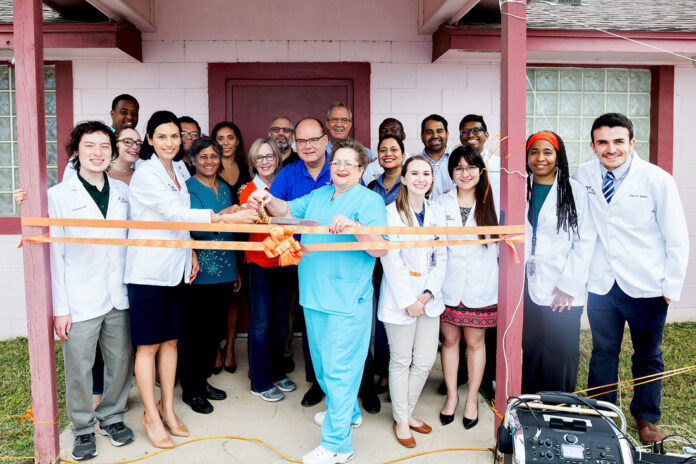BY Jennifer L. Berghom
It was a dream two years in the making.
On Saturday, March 24, a team of medical students from The University of Texas Rio Grande Valley School of Medicine celebrated the grand opening of its first student-run clinic at Proyecto Desarrollo Humano (PDH) with School of Medicine faculty and staff, representatives from PDH and the community.
Julien Mahler, a second-year medical student who was part of the group that spearheaded the endeavor, said he and fellow medical students, from the time they first set foot on the UTRGV campus to begin their medical careers, wanted to build relationships with Valley communities and help underserved areas gain access to free healthcare.
They chose to start their first clinic in Peñitas because there is a high demand for, but limited access to, healthcare services. Proyecto Desarrollo Humano has health clinic space and offers healthcare through volunteer health care professionals, but it is understaffed.
“What’s special about the student-run clinic is that not only does it bring student doctors and community members together, but it also gives us an opportunity to help families and community members understand the challenges of navigating the complex healthcare system,” Mahler said. “We can bring community members and faculty together to teach students that the health of the patients extends beyond the clinic and into the communities where people live. We can train the next generation of physicians to be advocates.”
The UTRGV SOM Student-Run Clinic will provide free primary healthcare services to residents in the Pueblo de Palmas community and surrounding neighborhoods. Services include:
· Screening for high blood pressure, diabetes and obesity.
· General physical/health and wellness visits.
· Available vaccinations and medications.
· Diagnosis and management of general conditions and symptoms.
· Minor injury care.
· Education for prevention of chronic health issues, and maintaining a healthy lifestyle.
· Referrals to specialty services, social services, and other community resources.
Medical students operate the clinic and treat patients under the supervision of clinical faculty. The clinic will operate once a month at Proyecto Desarrollo Humano. Patients currently are seen by appointment.
Nery Guerrero, a second-year medical student who helped establish the clinic and who grew up in the neighborhood where the students will operate the clinic, said it fulfills part of her dream to become a doctor and serve her community.
“This is very important to me because this is where my dreams, my education and my experiences came from,” she said.
She said she was pleasantly surprised when it was announced years ago that a medical school was opening in the Rio Grande Valley and, after she enrolled, she was excited to learn that her fellow medical students shared her passion for helping the community.
“That meant there wasn’t going to be one doctor coming here, there were going to be many doctors coming here … everyone wanting to come here and help my home,” she said.
Dr. John H. Krouse, dean of the UTRGV School of Medicine and executive vice president for Health Affairs, said the student-run clinic provides an opportunity to fulfill the School of Medicine’s mission to provide healthcare to people who otherwise would not have access to it.
That is especially important for people who suffer from chronic diseases such as diabetes, which has a prevalence rate of 30 percent in the Rio Grande Valley, he said.
“When patients cannot get access to care, they get many bad consequences of diabetes, but if you catch it early, it’s very treatable,” Krouse said. “We, therefore, have it as our mission to make sure we are in the community providing care and services that are needed by our residents.”
Proyecto Desarrollo Humano leaders called the partnership with the School of Medicine a win-win situation.
“It really is, for me, a very humbling experience to be able to work with the community,” said Shirley Arnolde, clinic administrator for Proyecto Desarrollo Humano. “Not only do communities with uninsured and low-income individuals need medical care, but also the new medical students need to learn how to treat individuals, and I’m hoping that, with this partnership, that it is being achieved.”
Following the ceremony, medical students, under the supervision of faculty and staff, began seeing patients, as representatives from the School of Medicine and other community groups held a health fair and other activities.




